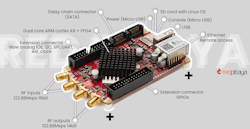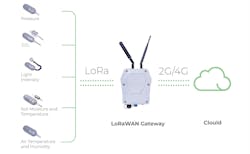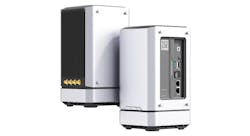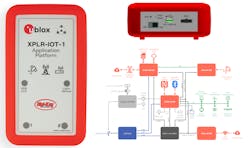Check out more Sensors Converge coverage.
Digi-Key's Scott Raeker discusses some IoT kits and and an FPGA-based test and measurement system, including ones from Red Pitaya, Seeed Studio, and u-blox.
FPGA Software-Defined Radio Platform
The Red Pitaya SDRlab 122-16 is a software-defined-radio (SDR) system based on Xilinx's Zynq SoC (Fig. 1). The platform has a pair of 50-Ω inputs connected to 16-bit ADCs. Dual 14-bit DACs drive the two 50-Ω outputs.
The system comes with open-source tools and software, and it can be controlled remotely using development tools like LabVIEW, MATLAB, Scilab, as well as Python. There are also oscilloscope, signal-generator, spectrum, and logic-analyzer applications that work with the system. These can be handy for development work as well as providing a programmable test-and-measurement system.
LoRaWAN Development Kits
Seeed Studio LoRaWAN support spans individual modules through kits that include gateways and evaluation boards (Fig. 2). LoRaWAN is a low-speed, long-distance wireless network that's ideal for many IoT applications in areas such as smart agriculture and smart cities.
Seeed Studio's LoRa systems range from modules that can be incorporated into an embedded system as well as fully functional, rugged systems designed for field deployment.
The demo tied the sensors and gateway to applications running on a Seeed Studio reServer (Fig. 3). The platform is available with different processors such as NVIDIA's Jetson AGX Orin and Intel Core i3. It has two 2.5-Gb Ethernet ports as well as optional wireless support for protocols such as 5G, LoRa, Bluetooth, and Wi-Fi.
Exploring IoT
Developers looking to build a fully functioning IoT prototype can start with the u-blox XPLR-IOT-1 (Fig. 4). It includes a dual-core, Arm Cortex-M33 application processor and can be configured to handle a range of sensors and wireless protocols including NFC, GPS, cellular, and short-range radio systems.
The system supports Thingstream MQTT for IoT connectivity. Cellular support features 400-MHz LTE-M and NB-IoT with Secure Cloud.
On-board sensors include accelerometers, magnetometers, gyroscope, ambient-light sensor, and battery gauge. There's a Qwiic connector for expansion. The protective silicone case allows for real-world deployment. Preloaded firmware provides access to sensors and the cloud via Thingstream.



